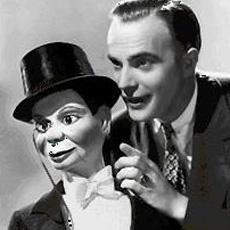(单词翻译:单击)
听力文本
Welcome to THE MAKING OF A NATION – American history in VOA Special English. I'm Steve Ember. Hard economic times and social conflict have always offered a rich source of material for artists and writers. A painter's colors can show the drying of dreams or the flight of the human spirit. A musician can express the tensions and uncertainty of a people in struggle. The pressures of hard times can be the force to lift a writer's imagination to new heights. So it was during the nineteen-thirties in the United States. The severe economic crisis -- the Great Depression -- created an atmosphere for artistic imagination and creative expression. The common feeling of struggle also led millions of Americans to look together to films, radio, and other new art forms for relief from their day-to-day cares. This week in our series, we tell about American arts and popular culture during the nineteen-thirties.The most popular sound of the nineteen-thirties was a new kind of music called "Swing." And the "King of Swing" was a clarinet player named Benny Goodman. Benny Goodman and other musicians made swing music extremely popular during the nineteen-thirties. Swing was a new form of jazz. Many of its first players were black musicians in small, unknown groups. It was only when more well-known white musicians started playing swing in the middle nineteen-thirties that the new music became wildly popular. One reason for the popularity of swing music was the growing power of radio during the nineteen-thirties. Radio had already proven in earlier years that it could be an important force in both politics and popular culture. Millions of Americans bought radios during the nineteen-twenties. But radio grew up in the nineteen-thirties. "Howdy, Folks. Yes, it is your old friend Singing Sam, so let's just settle back and reminisce a bit, what you say, huh?" Producers became more skillful in creating programs. And actors and actresses began to understand the special needs and power of this new electronic art form.

But even more popular were the many series of weekly programs, whether comedy, suspense, or drama. "The Lone Ranger Rides Again...Easy, steady, big fella" Families would gather around the radio, and thrill to the adventures of "The Lone Ranger," or laugh at the funny experiences of such comics as Fred Allen, Jack Benny, Edgar Bergen and his wooden ventriloquist's dummy Charlie McCarthy, WC Fields, and George Burns and Gracie Allen. "Yes, it's 'Maxwell House Coffee Time,' starring George Burns and Gracie Allen." Radio helped people forget the difficult conditions of the Great Depression. And it helped to bring Americans together and share experiences. Swing music. Classical music. Great comedy programs. The nineteen-thirties truly were a golden period for radio and mass communications. But it was also during this period that Hollywood and the American film industry became much more skilled and influential. In previous years, films were silent. But the "talkies" arrived in the nineteen-thirties. Directors could produce films in which actors could talk. Americans reacted by attending film theaters by the millions.
重点解析
1.millions of 数百万的;成百万的
He helped energize and mobilize millions of people around the nation.
他帮助激励和动员了全国数百万人。
2.a series of 一系列;一连串
The students have put forward a series of questions.
学生们提出了一系列问题。
3.be able to 会;能够
They may be able to help with childcare so that you can have a break.
他们可以帮忙照料孩子,这样你就可以歇一歇了。
4.grow up 兴起;逐渐发展
But now it's time for that brand to grow up along with her.
但现在是时候让品牌形象和她一起成长了。
参考译文
欢迎收听VOA慢速英语之建国史话节目,我是史蒂夫·恩伯。经济困难时期和社会冲突一直为艺术家和作家提供了丰富的素材来源,画家的色彩可以表现梦境的干涸或人类精神的飞逝,音乐家可以表达一个民族在斗争中的紧张和不确定。艰难时期的压力,可能是将作家的想象力提升到新高度的力量。30年代的美国,严重的经济危机——大萧条,创造出一个艺术想象力和创造性表达的氛围。这种共同的斗争感也促使数百万美国人一起去看电影、收听广播,还有其他新的艺术形式,以摆脱日常的忧虑。在本周的系列节目中,我们将讲述20世纪30年代的美国艺术和流行文化。20世纪30年代最流行的音乐是一种叫做“摇摆乐”的新型音乐,“摇摆之王”是一位名叫本尼·古德曼的单簧管演奏者。本尼·古德曼和其他音乐家,使摇摆乐在20世纪30年代非常流行。摇摆乐是爵士乐的一种新形式,最初的许多演奏者都是一些不知名的小型团体中的黑人音乐家。直到20世纪30年代中期,当更多知名的白人音乐家开始演奏摇摆乐时,这种新音乐才广为流行。摇摆乐流行的一个原因,源于20世纪30年代收音机的影响力越来越大。早些年已经证实,广播可以成为政治和大众文化的重要力量。在20世纪20年代,数以百万计的美国人购买收音机。但是,收音机是在20世纪30年代才发展起来。“大家好,没错,我是你们的老朋友斯英·山姆,我们舒舒服服地坐下来,追忆一下往事,你们说怎么样?”制作人在制作节目方面变得更加娴熟,演员们开始了解这种新型电子艺术形式的特殊需要和力量。
摇摆乐并不是由收音机带动流行起来的唯一一种音乐。20世纪30年代,莫扎特、贝多芬、勃拉姆斯和其他伟大作曲家的传统古典音乐也越来越受欢迎。1930年,哥伦比亚广播公司(CBS)开始在周日下午,播放由纽约爱乐乐团演奏的一系列音乐会。第二年的圣诞节,美国国家广播公司(NBC)在纽约大都会歌剧院的舞台上开始每周播放歌剧节目。1937年,NBC邀请意大利的阿图罗·托斯卡尼尼指挥美国电台的管弦乐队。托斯卡尼尼是当时最伟大的乐队指挥。圣诞节之夜,当托斯卡尼尼和NBC管弦乐队开始演奏十场特别广播音乐会中的第一场时,数百万美国人都在聆听。这对音乐和广播来说都是一个伟大的时刻,数百万美国人第一次能听到由伟大作曲家谱写的古典音乐。音乐是上世纪30年代数百万美国人聚集在一起听广播的一个重要原因。
但更受欢迎的是每周播出的许多系列节目,无论是喜剧、悬疑剧还是戏剧。“独行侠又骑上马……轻松、稳健的大男人”家人们聚在收音机旁,为《孤独的护林员》的冒险故事感到兴奋,或者因为弗雷德·艾伦、杰克·本尼、埃德加·伯根和他的木偶腹语演员查理·麦卡锡、WC·菲尔兹、乔治·伯恩斯和格雷西·艾伦等喜剧中的有趣经历而大笑。“是的,现在是由乔治·伯恩斯和格雷西·艾伦播出的《麦克斯韦之家咖啡时间》。”广播帮助人们忘记了大萧条时期的艰难处境,有助于把美国人聚集在一起,分享经验。摇摆乐、古典音乐、超棒的喜剧节目,20世纪30年代确实是广播和大众传播的黄金时期。但也正是在这一时期,好莱坞和美国电影业的技术更为娴熟,也更具影响力。前几年,电影是无声的。但在20世纪30年代出现了“有声电影”。导演可以制作出演员能交谈的电影,数以百万计的美国人去电影院看电影。
译文为可可英语翻译,未经授权请勿转载!


